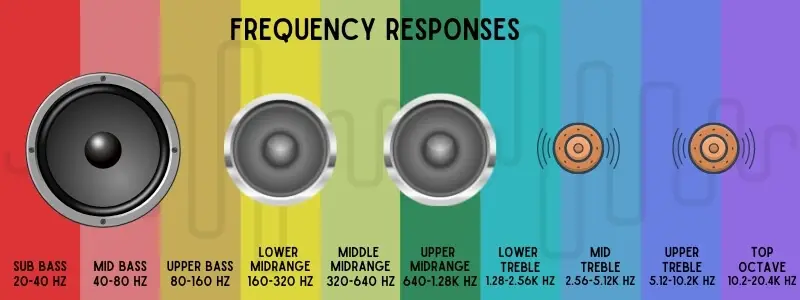Mid-Bass vs Mid-Range – A Beginners Guide
The sound frequency spectrum that’s audible to the human ear is 20 Hz to 20,000 Hz, but many people get confused with the mid-bass vs mid-range speakers and frequencies.
Any audiophile can discern the difference with both the sound frequency and probably the size of the speaker. But of course, not everyone is a seasoned audiophile and the nuances of many different audio components can be confusing.
Mid-bass vs mid-range confuses many and it’s probably down to them being speakers with the prefix mid- beforehand.
But what is the difference, and what exactly are mid-bass speakers? How do they differ from mid-range speakers, and which should I get?
All these questions and more are answered in the detailed article below which explains the similarities and differences when it comes to mid-bass vs midrange.
Mid-Bass vs Mid-Range – What Do They Have In Common?
Mid-bass and Mid-range refers to the different sound frequencies covered by the mid-bass and mid-range speakers that fall under this bracket.
The speakers are usually made with the same materials, and the cones are of course the biggest part of the speaker, but the construction is pretty much the same, with a conical shape that’s designed to output a wider dispersion of air.
The rest of the mid-range and mid-bass speakers are designed very similar with the surround, dust cap in the middle, with all the voice coil, speaker basket, spider, and magnet making up the main parts of the speaker engine.
But other than them being speakers and starting with the prefix mid-, there’s not many other similarities with mid-bass vs midrange. So, with that said, let’s take a look at the differences.
Mid-Bass vs Mid-Range – What’s Different About Them?
The main difference with midbass and mid-range is the frequencies they cover. As you may guess with the name, mid-bass speakers are made to reproduce lower bassier frequencies.
Mid-bass speakers generally cover the frequency range from 80 Hz to 350 Hz, and while the crossover will filter mid-bass out at 350 Hz, it’s here where your mid-range speakers take over up until around 5 kHz, when your treble kicks in.
Another difference is the size of the speaker. Because lower frequencies need more air to be moved the mid-bass speakers are usually bigger than the mid-range speakers.
It all depends on the brand, but mid-range speakers can be smaller because they need to move less air. So, in a set of 3 way speakers, you will see the mid-bass woofer, which will be the advertised size of the speaker: 6.5”, 6×9” or 8” etc.
The other 2 drivers will be the mid-range speaker, which might be 3 or even 4 inches for component speakers, and as small as 1-2 inches on coaxial speakers, and also the tweeter which will be the smallest driver.

Why Get Mid-Bass Speakers?
Mid-bass as the name suggest is a frequency that covers lower frequencies, but not as low as a subwoofer can cover.
Mid-bass frequency is generally from 80Hz upwards to about 350 Hz, and works better on that frequency than subwoofers or mid-range speakers can. Although, subs and mid-range can cover the mid-bass range, just not as well as the dedicated mid-bass speakers.
That said, only the true audiophile should go for the mid-bass speakers, because your average person might not even notice the difference as long as they have a subwoofer and mid-range speakers installed.
But for anyone who wants the perfect soundstage mid-bass speakers add that extra clarity to the higher bass region.
This is especially true for bass lovers who enjoy the smoothest and clearest transitions from the lowest bass to the highs of mid-bass. Having this set up will ensure you hear every detail in the different tones of bass.
Mid-bass is also good for anyone who’s on a budget or don’t have space for a subwoofer in the car. Subs can be expensive and they also take up a lot of space, so if you can’t get one for whatever reason, a mid-bass will do a decent job of a sub. And as long as you get 3 way speakers, you will get a smaller mid-range speaker, too.
Why Get Mid-Range Speakers?
Mid-range is from 80 Hz to 5 kHz, but dedicated mid-range speakers cover the frequency range between 250 Hz to 5 kHz. Although if you don’t have any mid-bass speakers the mid-range speakers will cover the frequency down to 80 Hz, just not as well as a dedicated mid-bass speaker.
The main difference with mid-range vs mid-bass speakers is that a mid-range will cover the higher frequencies from 350 Hz up to 5000 Hz, whereas the mid-bass is only designed to do the higher bass frequency.
You can install just mid-range speakers, but it isn’t an ideal set up, because they will be overworked and won’t reproduce the lows or work fluently with the tweeter either.
Not forgetting, it could be damaging to your speaker and to the sound of your music. But it’s the same for all speakers: none of them will do the full range and sound perfect.
Instead, getting a midrange speaker along with a subwoofer and tweeter will ensure you cover the full frequency spectrum sufficiently and the transition between frequencies will be much smoother.
Which Should I Buy: Mid-Bass vs MidRange
As with most things in the audio industry, there’s no definite winner. It’s really down to personal choice and needs, and really your ears are the final judge of the sound quality delivered.
Of course, it’s not feasible for everyone to buy both, but if you want to boost your car stereo with an extra set of mid-bass or mid-range, which should it be?
Midrange speakers are a necessity for anyone looking to upgrade their sound system, and midbass speakers are a necessity for anyone who wants to sculpt the very best sound possible.
Both mid-bass and mid-range are very different and offer so much to the sound quality in your car stereo system. They both specialize in their specified frequency range, so the best result is to buy both.
If you don’t want to get both, think about the sound you really want before you go shopping. Do you want a deeper bassier sound? Go for mid-bass speakers. Do you want good overall sound, but go lighter on the bass? Go for mid-range.
If they are your only speakers (not advised), you should probably go for mid-range, because it will cover the whole frequency band, although the 80 – 350 Hz frequency won’t be as clear as with some additional mid-bass speakers.
That’s because using dedicated mid-bass speaker takes the burden of the mid-range speakers for reproducing both the midrange and higher bass frequencies.
If you get a mid-range coaxial, it will probably be a 2 way speaker that covers the full range, but they will be limited especially at the crossover points, and the transitioning will be harsher sounding. However, if you add some mid-bass speakers you will be adding more depth to the sound, as you free up the 2 -way coaxial to work on the mid-range frequency.
When it comes to 2 way vs 3 way speakers, I would recommend the 3 way components. These are definitely the best option for most, as most good quality 3 way spekaers boast a good mid-bass and mid-range drivers.
A typical set of 3 way component speakers will include a big mid-bass (6-8 inches), a smaller mid-range (3-4 inches), and a tweeter (1 inch). This won’t produce absolute clarity throughout the frequency spectrum, but it will be easier to install and configure than getting a dedicated and separate driver for each frequency.

I am a passionate and skilled car audio enthusiast with 15 years of experience in the industry. My journey started when I replaced my first set of factory car speakers, sparking a deep love for high-quality sound. Since then, I have worked as a representative for renowned brands like Kenwood and Alpine.
With a background in both retail and distribution, I have developed a comprehensive understanding of the car audio market. Currently a certified (MECP) installer in the Mobile Electronics industry, my expertise lies in delivering top-notch audio installations. My knowledge, coupled with my genuine passion, makes me the go-to professional for all car audio needs.

